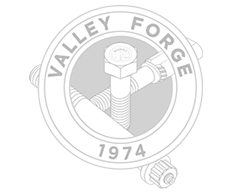The Latest At Valley Forge
As the world continues to navigate through the COVID-19 pandemic, Valley Forge would like to provide an update regarding our employees, facility and our continued ability to fulfill our customers’ orders.
All parts manufactured at Valley Forge are made with U.S. domestic steel and our raw material supply for this and other materials/components remains strong and unaffected. We have not experienced any disruptions in our supply chain and have increased our inventory of raw materials. Additionally, through continued best manufacturing procedures and innovations, we have managed to reduce lead times to 4 weeks on standard parts.
In compliance with state-mandated precautions, we are continuing to wear masks, wash hands, physical distance, have daily temperature checks and limited group sizes to no more than 5 employees. We have also instituted additional cleaning and sanitizing of common areas, restricted onsite visits, suspended sales travel to customer locations and have tested 100% of our employee base for the virus with some being tested multiple times.
We have had numerous calls with customers through electronic video conferencing platforms including Zoom, TEAMS and Skype and have established those same means of conducting our internal meetings. If this is something your team can benefit from, please contact us at Sales@VFBolts.com.
Together, we will continue to move through this trying time and continue to meet 100% of your bolting needs.
Wishing health and safety to you, your families and your employees.
Michele Clarke
Chief Executive Officer
What if you bought a mine and 6,000 bolts were improperly tensioned?
Buying a mine with an unknown maintenance history and a multitude of bolts showing signs of improper tension is a worst-case scenario. Yet even in this situation, load indicating fasteners can still save big money and thousands of man hours. A mine operator in Latin America made this discovery when it purchased such a mine. Inexplicably, the previous owner had neglected its mills, and nearly every bolt was not tensioned to the correct design load. However, as luck would have it, the mills were entirely outfitted with SPC4 Load Indicating Fasteners from Valley Forge & Bolt.
Tackling trouble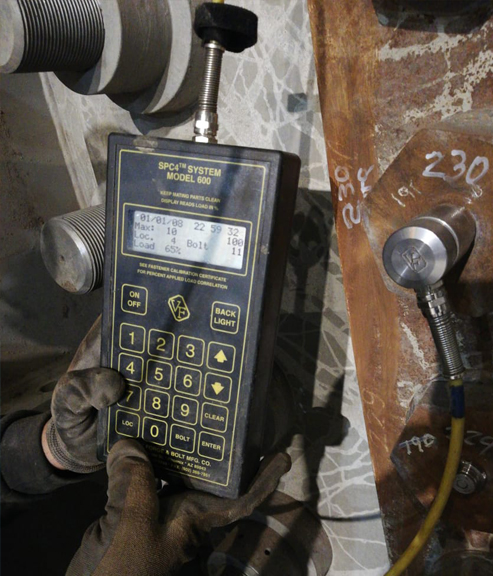
The first hint of trouble? Bolts were loose in their joints, at 0% tension. The mine was running two processing lines, each with one SAG mill and two ball mills, for a total of six mills. With each mill containing approximately 1,000 bolts, there were 6,000 bolts that needed to be checked. It was a monumental task.
The mine’s new owner reached out to Protorq, Latin America’s premier distributor and installer of Valley Forge SPC4 and other fastener products. In the face of a seemingly impossible situation, the one saving grace was the presence of the SPC4 Load Indicating Fasteners, which opened up a range of time- and money-saving options that simply would not have been possible with any other type of bolt.
SPC4 fasteners contain proprietary technology that measures tension as a percentage of minimum yield from directly inside the bolt. The information is relayed from a datum disc on one end of the bolt to a variety of Valley Forge meters and displayed in an easy-to-read digital or mechanical format.
“With SPC4, it couldn’t be any easier to check fastener tension,” said Bret Halley, chief operating officer of Valley Forge. “The previous mine owners simply weren’t using the technology and capabilities that were right in front of them.”
Protorq crews used the SPC4 meters to ascertain the load of each of the 6,000 bolts across the six mills. The wide range of load percentage was staggering—from bolts hanging loose at 0% all the way to significantly over-tensioned bolts well over 100% of minimum yield strength. Protorq was directed to replace the over-tensioned bolts, as the mine operator had determined the over-tensioning had compromised the bolts’ integrity. In all, 100 bolts had to be completely replaced. Under-tensioned bolts were simply re-tensioned to the correct load using the SPC4 meters.
Ultrasonic testing not an option
What if the same scenario had existed, but with standard bolts rather than SPC4? Some might believe that ultrasonic testing would have been an equally easy solution. The fault in that thinking is this: There were no baseline measurements recorded by the previous owner after the bolts’ initial installation. As a result, Protorq’s crews would have needed to first remove and then re-install or replace all 6,000 bolts to recreate this baseline measurement. Conversely, the SPC4 system allowed them to replace only the 100 bolts that were over-tensioned, saving hundreds of maintenance hours.
SPC4’s immediate and ongoing benefits
Protorq’s 30-man crew spent 35 days, spread over several months, to completely rehab the six mills. Protorq’s general manager, Gonzalo Diaz, estimates that without SPC4 it would have taken three times as long. “Without SPC4 technology, this easily would have been a 100-day undertaking,” said Diaz. Multiply each additional day by 30 crew members, and it’s easy to see how the man hours saved would stack up quickly.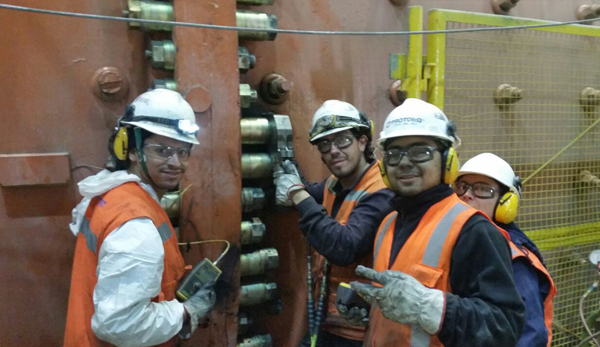
SPC4 also comes with other benefits for mines and their mills. The Model 600A digital meter, which was left with the mine on completion of the rehab project, features data-logging capabilities. Tension data collected from the SPC4 fasteners can be uploaded to mine computers to develop a clear picture of vibration hotspots. The meter also creates an automatic record of tension data at install or re-tensioning, so the mine will never again be without this information.
Another meter type, Model 702-02, works wirelessly and incorporates bolt tension information into existing condition-monitoring systems. Wireless meters send scheduled, periodic data reports to the central system, offering in-situ load readings of critical joints. Maintenance managers become familiar with bolt activity by recognizing patterns in the changes to bolt tension, signaling that the joint is in need of attention. This insight could prevent costly bolt failures and time-consuming unplanned maintenance downtime.
Preserving a multimillion dollar investment
Halley points out another advantage. “Properly tensioned bolts prevent slurry ingress into a mill’s critical joints. Once slurry gets in, it becomes a permanent issue over the life of the mill. It can lead to chronic bolt failure.” He describes the exponential growth that starts with a small cluster of just a few bolts that fail, which quickly becomes 10 bolts, then 20, and so on.
This is significant, since mills are in service for an average of 30 years. Using SPC4 Load Indicating Fasteners from the beginning, and using them properly, can reduce this risk, which saves incalculable time and money over the life cycle of the mill. “Not only that, it protects a multimillion-dollar investment in that mill,” Halley said.
Diaz, Protorq’s general manager, says that mine owners not properly taking care of equipment is, unfortunately, a larger problem than one might imagine. “The results are often catastrophic,” said Diaz. “Luckily in this case, we had SPC4. That made all the difference in allowing us to tackle the problems in a timely manner and bring the mills back to health.”
Failing flanges saved by extra-long load-indicating fasteners
A mining operation is only as good as its ball mills, which a precious metals mine in British Columbia, Canada, discovered the hard way. A simple disruption in the mating of flanges in the ball mill was causing tens of thousands of dollars in losses on a weekly basis. It took a new kind of fastener, and a manufacturer with an innate understanding of bolting technology, to remedy the problem.
With the flanges not mating properly, bolt breakages in the mill were occurring on nearly a daily basis. Bolt changeouts typically lasted four hours, at a cost of $9,000 per hour in lost production. Multiple outages costing roughly $36,000 each occurred every week, adding up quickly. Not to mention they’d been going on for two years.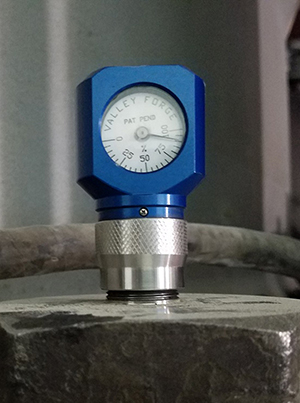
On top of the high price of bolt replacement, the mine was also losing money in the form of restart costs. The power drain associated with restarting the motors on four 12,000-horsepower mills sent hydro costs skyrocketing.
Mine maintenance engineers tried a number of potential fixes, but nothing worked. They contacted several different fastener companies, with no resolution–until they reached out to Valley Forge & Bolt, maker of fasteners with Load Indicating Technology. Valley Forge engineers took careful measurements of the troublesome mills and their flanges and extensively studied the various strains to which the mills were being subjected.
After reviewing the results, Valley Forge engineers determined the mill’s maintenance staff needed a method of monitoring bolt tension so they would have some warning of emerging issues. Engineers also wanted to extend the grip length of bolts used in the ball mills.
Valley Forge engineers specified the company’s exclusive SPC4™ Bolts with Load Indicating Technology for the application. SPC4 bolts have built-in load indicators that measure bolt load from directly inside the bolted joint. A datum disc on the end of each bolt translates this information and relays it to digital meters, where it is displayed as a percentage of load. The result is an easily readable numerical display that measures actual tension within the fastener, accurate to within +/-5%.
Now, rather than relying on far less accurate torque-to-tension conversion formulas, mine maintenance staff can monitor critical joints and be aware of tension loss well before catastrophic failure.
In addition to including Load Indicating Technology, Valley Forge specified extra-long bolts for the mine. The company supplied 17-inch bolts, rather than 13-inch, and dual 2-inch sleeves to be used with each bolt. The rationale behind the recommendation is that, for given service loads in the joints, bolts with the longer grip lengths will be more forgiving to flange separation caused by mill charge movement. The longer bolts increased the grip length of each joint by nearly 40%, from 10.5 inches to 14.5 inches.
According to the mill’s maintenance manager, “Valley Forge & Bolt instructed us in the fine art of bolting technology. I didn’t think I could ever learn this much about bolts.” By the mine management’s own estimation, changing to the Valley Forge SPC4 Bolts with Load Indicating Technology saved them $20 million.
 Protorq is among Chile’s leading bolt maintenance companies, growing its business since 1995 in performing changeouts for shell liner bolts in mining applications and hydraulic tensioning for flange joints. Protorq’s executive director, Carlos Recart, understands the value of always knowing the tension of critical bolted joints, and he knows how to achieve it: with the proprietary SPC4™ Load Indicating System and Maxbolt™ Load Indicating Fastener System, both from Valley Forge & Bolt.
Protorq is among Chile’s leading bolt maintenance companies, growing its business since 1995 in performing changeouts for shell liner bolts in mining applications and hydraulic tensioning for flange joints. Protorq’s executive director, Carlos Recart, understands the value of always knowing the tension of critical bolted joints, and he knows how to achieve it: with the proprietary SPC4™ Load Indicating System and Maxbolt™ Load Indicating Fastener System, both from Valley Forge & Bolt.
“What really matters on any critical bolted joint is the bolt’s tension rather than torque,” said Recart. “This isn’t just in mining; it’s also true of power generation, petrochemicals, refineries, and other industries. Proper bolt tension is where we must put our focus.”
Twenty years ago at the Expomin Mining Show in Santiago, Chile, Recart’s path crossed with that of Bret Halley, CEO of Valley Forge & Bolt. The Phoenix-based bolt maker is a pioneer in the manufacture of load indicating fasteners. These bolt and studs contain technology that measures the actual tension within a bolt and displays the information via built-in gauge, hand-held external meter, or Wi-Fi-enabled remote meter.
From the moment the two men met, Recart knew Valley Forge was onto something. “As I started to learn about what Valley Forge was doing with load indicating fasteners, I knew that I needed to work with them. And now it’s a long-standing relationship,” said Recart.
Recart recalls an early example of how Valley Forge’s load indicating fasteners helped one of his mining customers. It involved bolts that were continually breaking in one of the mine’s ball mills. The consequence was monthly work stoppages to allow for replacement of 10 bolts, always in the same positions.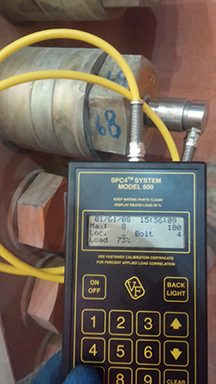
Downtime in mining, as in many other industries, is extraordinarily expensive. Each instance can easily cost tens of thousands of dollars in lost production. Recart suspected the mine workers had not been achieving the appropriate clamp load for the bolts in that area of the ball mill, because they had been relying on torque, not tension, as an indicator.
Recart’s solution was to replace the bolts in the suspect joints with Valley Forge’s SPC4 Load Indicating Fasteners, which directly measure the actual tension inside the bolt. The information is read using an external hand-held meter that digitally displays the fastener load as a percentage of yield from zero to 100. SPC4 bolts are accurate to within +/-5%, whereas torque-based tightening methods are only +/-20% accurate at achieving appropriate clamp load, a stunning range of 40%.
With SPC4 technology, users simply quick-connect the hand-held meter’s probe to the end of the SPC4 bolt and tighten until achieving the desired tension, with the ability to save the data by pushing just one button. After installation, it’s just as easy to check tension. Snap on the probe and read the display. If the bolt is out of tension, tighten it until proper tension is achieved. If it’s already at the proper tension, leave it alone.
“Using SPC4 from Valley Forge, we were able to show the customer that they had been just torqueing the bolts and not considering any variables that can affect the torqueing process,” said Recart. “They were not achieving the needed clamp load, which lead to bolts breaking because of fatigue.”
Once the customer started using SPC4, relying on its display to tighten the bolts to the correct tension, those previously problematic joints did not fail. Plus, the mine now had valuable information about what amount of tension constituted appropriate clamp load for the application.
“It’s a small example of how load indicating fasteners from Valley Forge are, by far, the easiest way to solve any critical bolted joint issue,” said Recart. “They have the answer for any kind of bolted joint, in any kind of industry, and put it at your fingertips. That’s everything. What else we could ask for?”
A career spanning four decades brings vast knowledge and experience
Valley Forge & Bolt, manufacturer of hot-forged industrial fasteners, is proud to welcome Rick Bailey to the company as chief metallurgist. Throughout his more than four-decade career, he has specialized in steel, the core component of Valley Forge products. Bailey will apply his scientific and technical knowledge as well as his leadership abilities to Valley Forge’s continued growth as the top supplier of fasteners and custom critical joint solutions. 
Bailey will be involved in numerous levels of the organization, with an eye on maintaining efficient, high-quality processes. His responsibilities include creating product formulations and purchasing steel; production planning; advising on forging and heat-treating; expanding employee understanding of product functions; and assisting with quality controls.
“My strength is in treating product creation holistically—taking raw materials and carrying them through forming, machining, and heat treating to get quality levels that customers need,” said Bailey. “My role is to turn science into practice, applying the technical side of metallurgy to improve processes. And to embrace continuous improvement so we’re always learning and better serving our customers.”
Bailey has vast prior experience serving the mining, power gen, and oil and gas markets, giving him intimate knowledge of three of Valley Forge’s core markets. He is invigorated by the opportunity to work on products that include the company’s proprietary Load Indicating Technology. “Often with Load Indicating Technology, we’re making huge bolts for heavy applications, where it’s crucial to start with material that has the correct properties so the finished product calibrates properly,” said Bailey. “I’m really happy to be part of an organization that’s making innovative, high-value products.”
“We’re extremely fortunate to add someone with Rick’s experience to the Valley Forge team,” said Michele Clarke, CEO. “He’s seen and done just about everything in steel metallurgy, and has developed a true passion for fasteners and solving customers’ issues with their critical joints.”
Bailey began his career with the venerable U.S. Steel and transitioned to the fastener side of the steel business with Massachusetts-based Olympic Manufacturing Group. Bailey’s wife has roots in Arizona, making his move to Valley Forge a homecoming of sorts.
Valley Forge Total Solutions Approach Can Save Mining Operations Millions
Mills are a crucial part of mining operations, but also a source of concentrated vibration that can wreak havoc with bolted joints. Most mills are expected to run continuously for extended periods—often months at a time—until scheduled downtime for maintenance. Depending on the mine, some mills can even require a total liner changeout every three months. It’s an accepted fact of life for a punishing environment, in which hardened material is rotated and smashed by hundreds of steel grinding balls within the mill shell, which works much like a large cement mixer. Material is constantly falling 40 feet within the shell, crashing into the charge and mill liners fastened to the inside of the mill. It is here, in the bolted joints that fasten each mill liner to the mill shell, where bolt loading can vary widely. 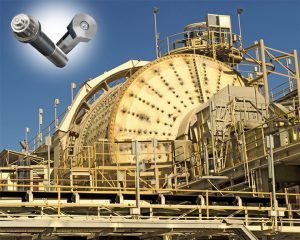
Because of this, it is vital that the fasteners used in the mills’ bolted joints maintain proper tension throughout these extended in-service periods. Improper bolt tensioning that requires mill stoppage can easily add tens of thousands of dollars to a mine’s operating costs. In mining for precious metals such as gold, these costs can quickly balloon into the millions.
In such circumstances, it is critical to have a bolt manufacturer with both an innate understanding of joint tension and the ability to offer analysis, advice, and support. Valley Forge & Bolt, which engineers and manufactures fasteners with Load Indicating Technology, offers its capabilities and expertise to mining customers through a multifaceted solution:
- Providing torque-to-tensioning verification equipment for better bolt-load accuracy
- Providing on-the-ground support
- Creating an application-specific blend of bolt materials
- Using exclusive Wi-Fi technology to hone bolt performance
Understanding the Mill Reline
A grasp of the relining process is crucial to understanding the total solution approach provided by Valley Forge.
Each mill liner is attached to the inside of the mill with multiple bolts. Each bolt is secured in place by means of a two-part process. First, impact wrenches are used to set a bolt partially in the joint. Then, torque multipliers are used for final tightening. Each reline requires hundreds of bolts.
After all liners and bolts are installed and initially torqued, the mill is turned on to run for a predetermined period of time, after which the bolts are retorqued to accommodate any shift during usage. The amount of time to wait between initial install and retorquing is an important factor in prolonging fastener life. In some instances, mine operators wait several days before retorquing. Valley Forge products and equipment can reveal what period of time is optimal.
Valley Forge Solutions
Mines can use the Valley Forge Clarkester™ Tester to calibrate their torque wrenches to bolt tension, vastly improving tension accuracy at installation. Purchase of the tester includes training from Valley Forge on the machine’s proper use.
By request, Valley Forge technical personnel are available to travel to the site to oversee liner replacement and help ensure it is performed properly.
Valley Forge Load Indicating Fasteners measure and display tension from within the bolted joint, accurate to +/-5% of true clamp load (compliant with ASTM 52 standards).
Valley Forge can increase ductility by creating an application-specific formula for manufacturing bolts needed for individual applications.
Valley Forge SPC4™ fasteners and SPC4 702 SERIES wireless sensors relay tension information back to a data-logging station, allowing tension to be read in situ.
The Result
The ability to read tension in situ means mine operators can determine when bolts are losing tension even if it’s just hours after the initial installation and preliminary start-up period. This information can revolutionize a mine’s approach to retorquing. Rather than three to four days after installation, bolts can be retorqued far sooner—astonishingly, some need to be retorqued within two to four hours of installation.
When mine operators adjust their retorquing schedule according to information gleaned from Valley Forge products, the result can be incredible. One mine that had been experiencing $1.6 million in downtime each month related to improper tensioning has now gone more than two years without any tensioning issues (saving a staggering $38 million over that time). Savings continue to grow each month.
Obviously, the amount individual mines will save depends on how much improper bolt tensioning is currently costing them. What is clear, however, is that Valley Forge Load Indicating Fasteners and related products, along with the company’s technical support, can help mine operators save time and money.
About Valley Forge & Bolt Co.
Valley Forge & Bolt Mfg. Co. is a manufacturer of standard and custom fasteners, proudly producing both for over 40 years. The company is a leader in controlled bolting and its load indicating fastener technologies offer unrivaled quality, extraordinary performance and enduring reliability. For more information on technologies to optimize the integrity of the bolted joint, call 800.832.6587 or visit vfbolts.com.

